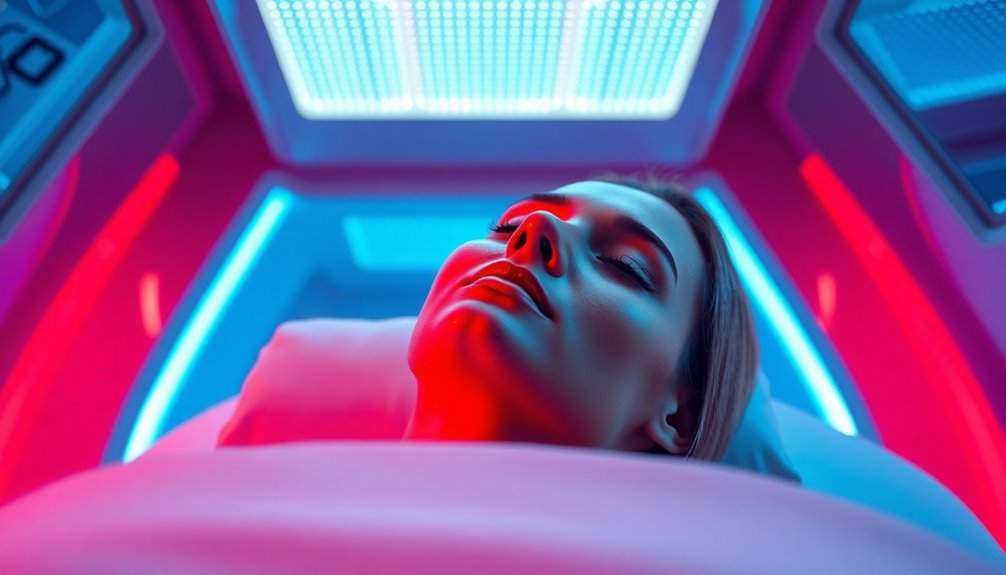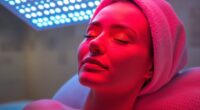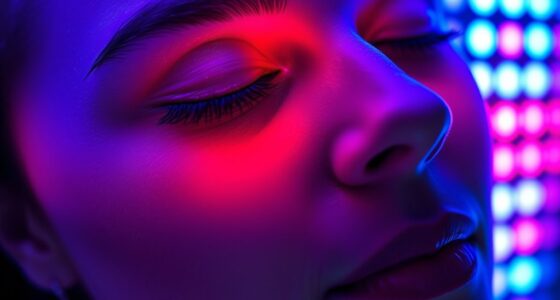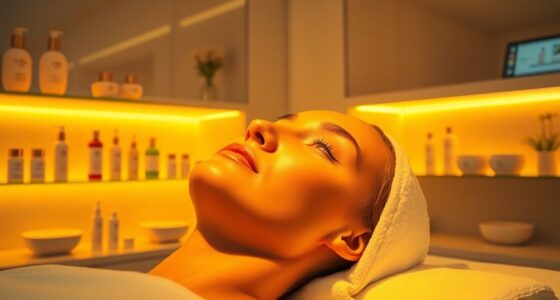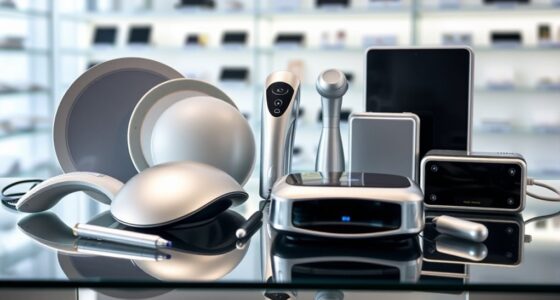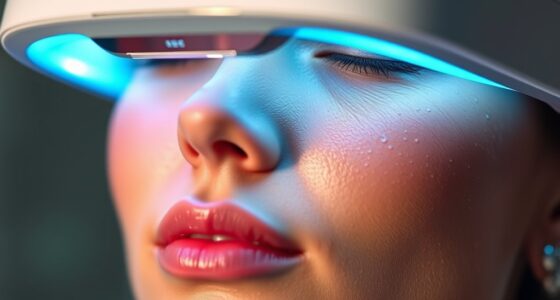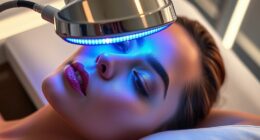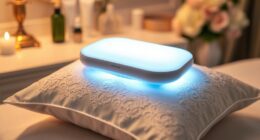LED light therapy works by using specific wavelengths of light to stimulate your skin cells. When you undergo this treatment, the light penetrates your skin, promoting collagen production and reducing inflammation. Different colors serve various purposes—blue tackles acne, while red fights signs of aging. Scientific studies back its effectiveness for healing and improving skin texture. While results can vary, many find it beneficial for various skin conditions. It's crucial to consult a dermatologist to tailor the treatment effectively to your needs. Want to understand the types and applications of LED therapy? There's more you can explore!
Key Takeaways
- LED light therapy works by absorbing photons, boosting ATP production, and enhancing cellular processes for skin rejuvenation.
- Different wavelengths target specific skin concerns, with red light promoting collagen and blue light treating acne.
- Scientific studies support the efficacy of LED therapy in improving skin texture, reducing wrinkles, and accelerating wound healing.
- Applications include managing conditions like acne, rosacea, and eczema, making it a versatile skincare option.
- Professional guidance is essential, especially for those on photosensitizing medications or with active skin conditions.
Mechanism of Action
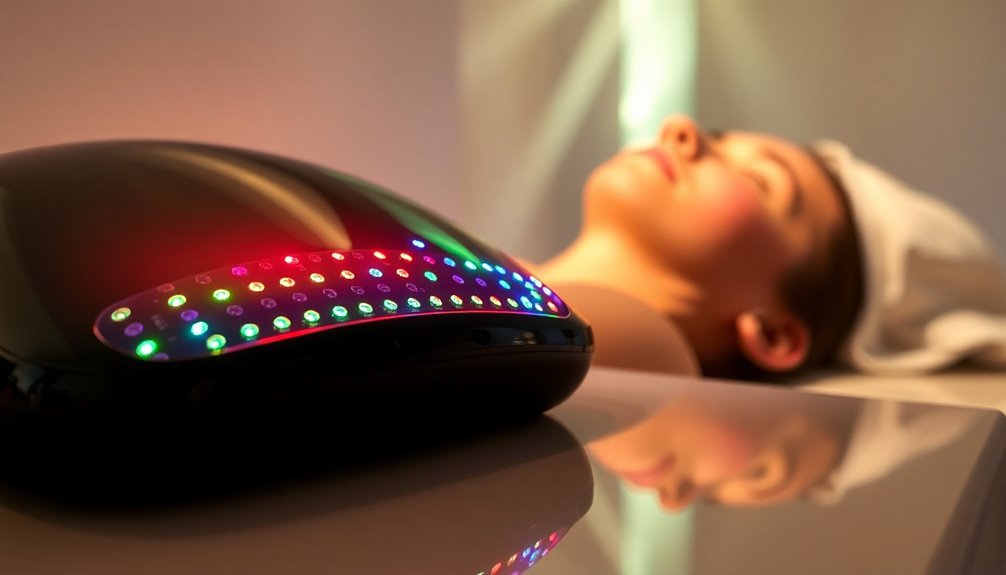
When you undergo LED light therapy, the process begins with the absorption of photons by cellular structures. This absorption puts your cells into electronically excited states, accelerating electron transfer reactions.
As a result, ATP production increases, which is vital for managing various cellular processes. Higher ATP levels modulate second messengers like cAMP and Ca2+, crucial for cellular functions. This leads to enhanced metabolic activity, promoting cell proliferation and migration.
Additionally, specific wavelengths of light stimulate cellular processes, including increased collagen production and reduced inflammation. Studies have shown that LED light therapy is particularly effective for anti-aging benefits, as it helps to enhance collagen production and improve skin texture.
Types of LED Light Therapy
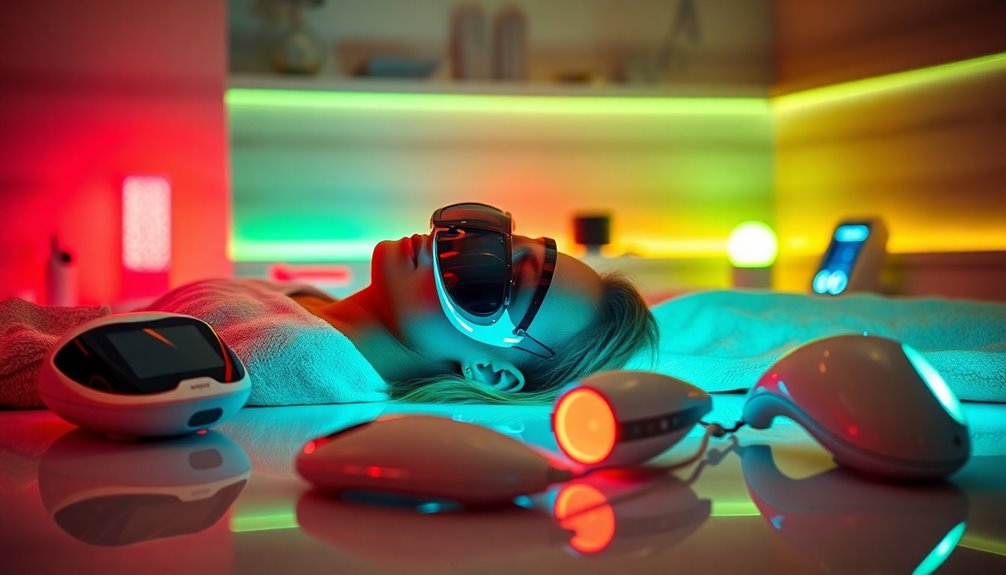
LED light therapy encompasses various types, each targeting specific skin concerns and conditions.
Blue light therapy's great for acne, as it kills bacteria and reduces inflammation. This type of therapy is particularly effective because it targets acne-causing bacteria.
Red light therapy stimulates collagen production, helping with scars, wrinkles, and even hair growth.
Near-infrared light penetrates deeper, enhancing skin elasticity and providing pain relief.
If you're looking for a boost in skin radiance, amber light therapy can reduce fine lines and be combined with other wavelengths for tailored treatments.
Lastly, green light therapy has specific applications, like treating skin cancers such as Bowen's disease, and can also work with red light for enhanced effects.
Each type offers unique benefits, so you can choose what suits your needs best.
Scientific Evidence
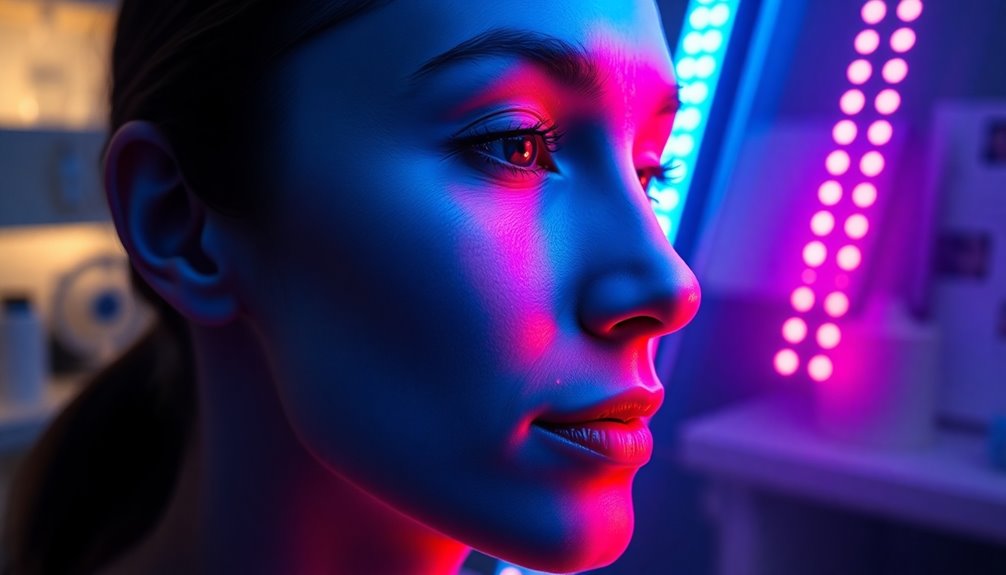
Although many people have experienced positive results from LED light therapy, scientific evidence supports its effectiveness through various mechanisms and clinical studies. Researchers have found that therapy lights effectiveness explained through cellular photobiomodulation can lead to increased collagen production, improved skin texture, and reduced inflammation. Additionally, clinical studies demonstrate that LED light therapy can be beneficial for a range of conditions, including acne, psoriasis, and even wound healing. As a non-invasive treatment option, it offers individuals an alternative to more aggressive therapies while promoting overall skin health.
LED therapy stimulates cellular processes, enhancing collagen and elastin production, which improves skin health and wound healing. Red light penetrates deeper than blue light, making it more effective for these purposes. Research indicates effectiveness across different wavelengths of electromagnetic radiation and the importance of continuous wave light at targeted wavelengths for efficacy.
Clinical trials have demonstrated accelerated healing of wounds and significant improvement in skin conditions like acne by reducing inflammation and promoting clarity.
Additionally, LED light therapy has shown promise in relieving pain and improving vision in patients with age-related macular degeneration.
While some studies report no significant differences over time, the overall therapeutic benefits make LED therapy a compelling option for skincare and healing.
Applications in Dermatology
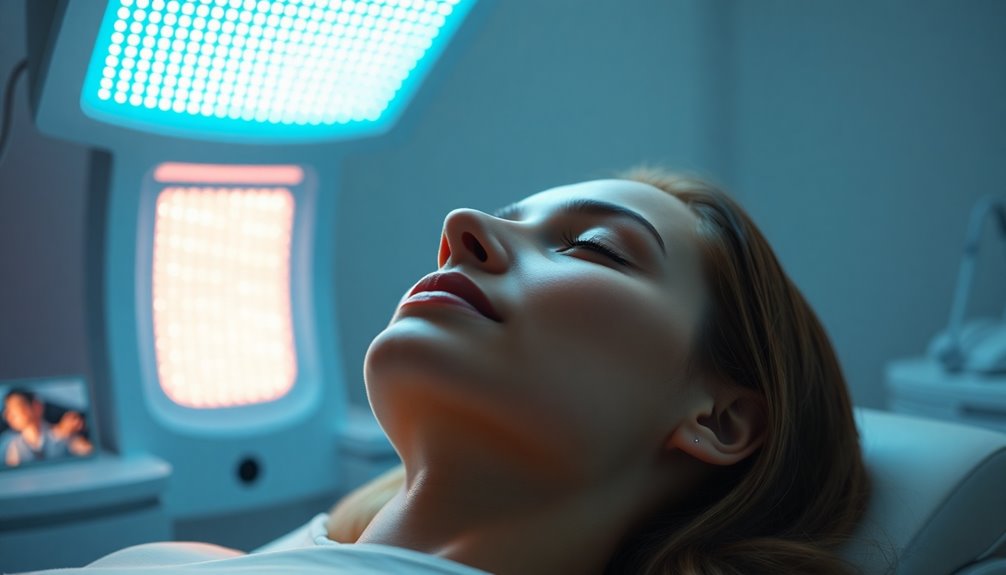
The therapeutic benefits of LED light therapy extend significantly into dermatology, offering various applications that cater to different skin concerns.
For acne treatment, blue light therapy targets sebaceous glands, reducing oil production and killing bacteria, while red light therapy helps reduce inflammation. Research indicates that multiple treatments are often required for noticeable results in reducing acne.
If you're looking to combat aging, red light stimulates collagen production, making skin appear more youthful. It can also assist in wound healing and scar reduction by promoting collagen and reducing inflammation.
Additionally, it can help manage skin conditions like eczema and rosacea by minimizing redness and inflammation. Always consult a dermatologist before starting any new treatments, especially if you have specific skin concerns, to ensure the best results for your skin type.
Benefits for Skin Health
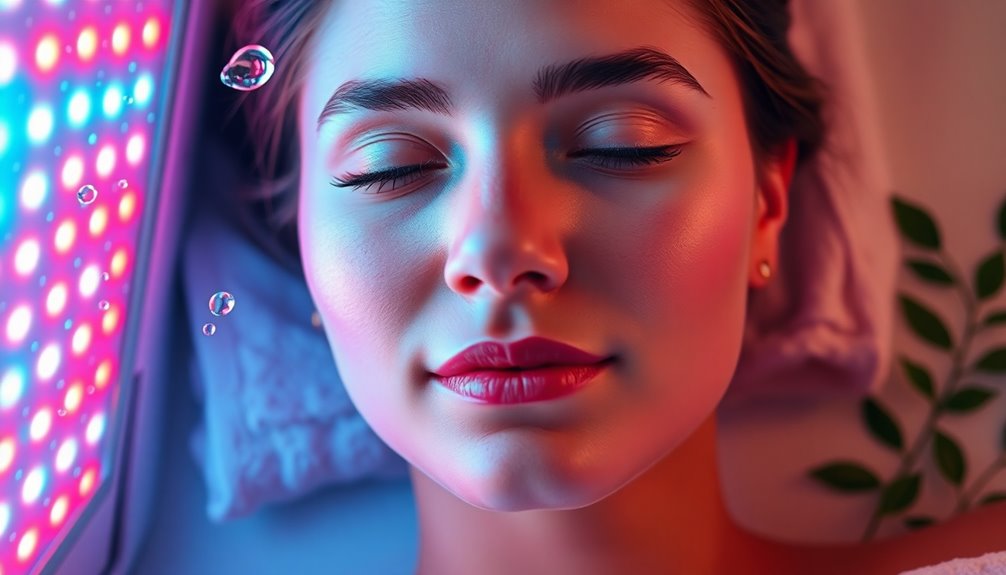
When considering ways to enhance your skin health, LED light therapy stands out as a powerful option. It effectively treats acne through blue light, which kills bacteria and reduces inflammation, while red light complements by easing redness. Additionally, using hydrocolloid patches in conjunction with LED therapy can provide targeted treatment for active blemishes.
If you're looking to combat aging, red light stimulates collagen production, improving skin elasticity and minimizing fine lines. Studies show that 45% of patients experience fewer wrinkles post-treatment. Additionally, increased collagen production from LED therapy refines skin tone and texture, reducing hyperpigmentation and revealing a more luminous complexion. It even promotes healing by speeding up recovery times and enhancing skin clarity.
With these benefits, LED light therapy can revitalize your skin, making it look healthier and more radiant overall.
Limitations and Precautions
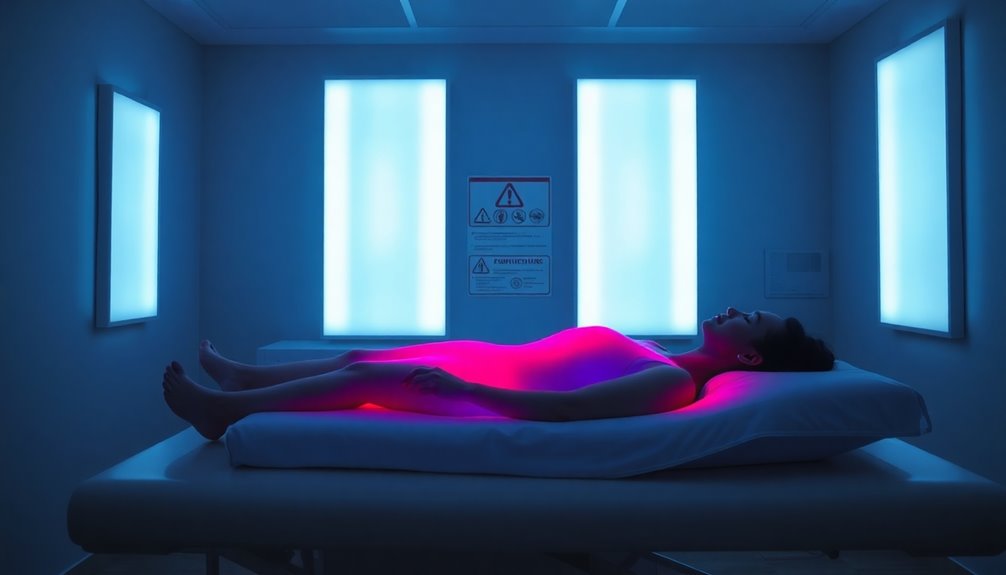
While LED light therapy offers numerous benefits for skin health, it's important to recognize its limitations and take necessary precautions.
If you're on photosensitizing medications like antibiotics or Accutane, consult a dermatologist first, as these can increase sensitivity and risk of side effects.
Always prioritize eye safety; use proper eye protection during treatments, especially since some home devices may lack this critical feature. Additionally, be aware that mild reactions like redness and swelling may occur after treatment, even in those without photosensitizing medications.
If you have active skin rashes or severe inflammation, avoid LED therapy, as it could worsen your condition.
Keep in mind that home devices are generally weaker and less consistent than professional-grade options, which can affect results.
Always seek professional guidance for optimal safety and effectiveness in your LED light therapy journey.
Frequently Asked Questions
How Long Does Each LED Light Therapy Session Last?
Each LED light therapy session usually lasts between 20 to 30 minutes, but this can vary based on the intensity and your individual response.
You might start with shorter sessions, around 15 minutes, and gradually increase the duration.
It's essential to follow manufacturer guidelines, as they recommend specific treatment times.
Consistency is key, so aim for daily use or at least three to five times a week for optimal results.
Can LED Light Therapy Be Used on All Skin Types?
Yes, you can use LED light therapy on all skin types.
It's a non-invasive and heat-free treatment, making it safe for everyone, including those with sensitive skin.
You won't experience downtime or side effects, which means you can easily incorporate it into your routine.
With its clinically proven effectiveness, LED therapy can target various skin conditions, ensuring you get the benefits regardless of your skin color or type.
Are There Any Side Effects From LED Light Therapy?
Yes, there are side effects from LED light therapy. You might experience headaches, especially if you're sensitive to bright light.
Eye strain can occur if you don't protect your eyes during sessions. Skin irritation, like redness or itching, can happen too, particularly if you have sensitive skin.
Additionally, some medications can heighten sensitivity, and you could face insomnia afterward. It's wise to consult a healthcare provider to minimize risks.
How Often Should I Undergo LED Light Therapy Treatments?
Imagine your skin soaking in a gentle sunrise; that's how LED light therapy should feel.
For low-power devices, treat yourself daily or every other day for 10-30 minutes.
If you're using medium-power devices, aim for every other day.
High-power devices are stronger, so stick to twice a week.
Always listen to your skin—it's your best guide.
Consistency is key, but don't overdo it; moderation keeps your glow radiant and safe!
Is LED Light Therapy Safe During Pregnancy?
Yes, LED light therapy is generally considered safe during pregnancy.
It's non-invasive and doesn't emit harmful UV rays. However, it's crucial to consult your healthcare provider for personalized advice.
While most women find it beneficial for mood and skin issues, individual responses can vary.
Be mindful of how your body reacts during treatments and avoid overheating, especially in the first trimester.
Choosing reputable devices is also important for safety.
Conclusion
In conclusion, LED light therapy offers promising benefits for skin health, from reducing acne to minimizing wrinkles. By understanding its mechanism of action, exploring various types, and considering scientific evidence, you can make informed decisions about its use. While it's effective for many, it's essential to recognize its limitations and take necessary precautions. Whether you're seeking rejuvenation or relief, LED light therapy might just be the glow-up your skin needs.
